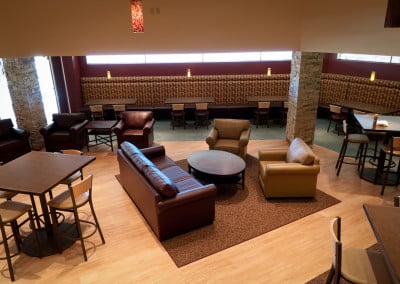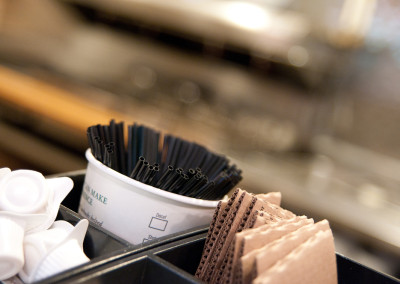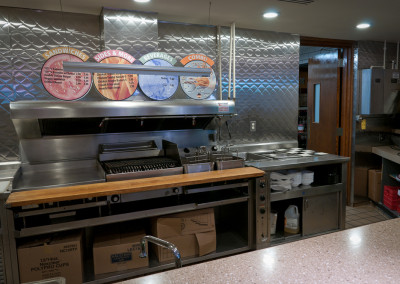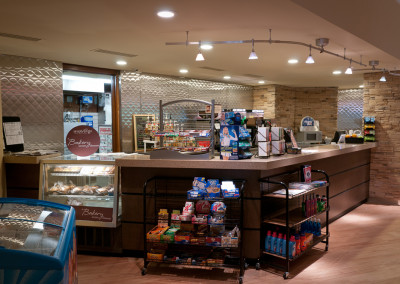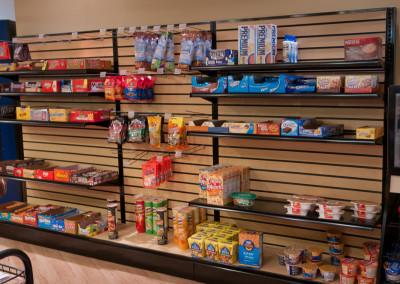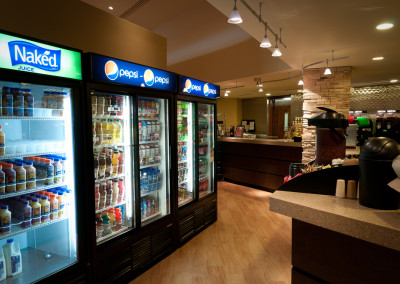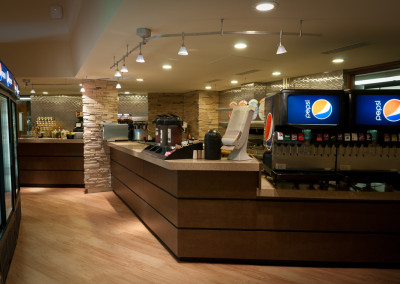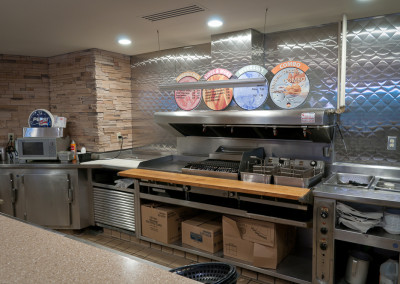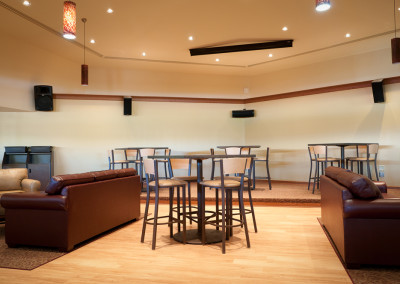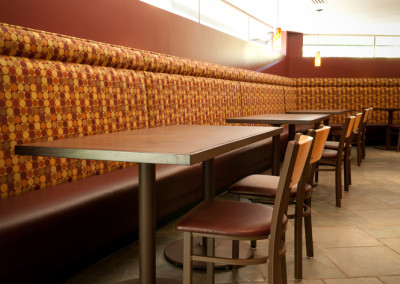Café Design Consultants
SERVING YOUR AREA
Ready to improve or build your food service operations? Contact us to talk to one of our experts right away!
or call 800-899-6604
Coffee Shop, Bakery, and Café Design
At its heart, a coffee shop or café is a specialized Quick Service Restaurant (QSR), and Rapids Contract offers decades of experience designing cozy cafés with efficient QSR kitchens to turn orders quickly. Today’s baristas can enjoy convenient access to the espresso machine, the multitudes of refrigerated beverage ingredients, and ice, and they can maintain good communication with servers and customers. Meanwhile, customers will queue up every day in your inviting café, tempted by enticing food displays to add a pastry or sandwich to their order.
Café Kitchen and Beverage Equipment
With the right kitchen equipment and efficient design, you can turn orders faster, improving the customer experience and turning more tickets. Optimize the productivity of your staff with proper placement of refrigerators, espresso machines, pastry ovens, ingredient tables, food displays, and sandwich prep counters. Plus, you can highlight pastry and retail items with tempting merchandise shelving.
Purchase from Rapids for full service, from staging to delivery to installation in your café. Or check out our online store of foodservice smallwares and equipment.
Get Ideas From Experts in The Industry
Success With Cafés of All Sizes
Energy Efficiency in Café Equipment and Optimizing Small Café Design
Save More, Earn More
A focus on energy-efficient design and equipment saves money by reducing energy costs and potentially qualifying your business for rebates and tax credits.
LEED-Certified Design
Rapids Contract enables you to lower your café’s carbon footprint and raise environmental awareness. Reap the long-term rewards of choosing energy efficient equipment, technology, and lighting for your coffee shop and café.
Small Café Design Experts
Get the most out of the smallest coffee shop or café with expert café design, focusing on efficency and execution.
Ease in your Cookline and Serve Line
We can help you create the most efficient workspace for baristas and develop clear paths for customer flow.

Frequently Asked Questions for Café Design
How long does it take to install a café kitchen?
The time it takes to install a café kitchen can vary widely based on several factors, including the size of the kitchen, the complexity of the design, the type of equipment being installed, local regulations and permits, the availability of contractors and skilled labor, and the efficiency of the installation process.
In general, smaller and less complex kitchens in an existing foodservice space might take a few weeks to a couple of months to install, while larger and more intricate kitchens could take several months. Here are some key factors that can influence the installation timeline:
1. Design and Planning: The design phase can significantly impact the installation time. If the kitchen’s layout and design are well-prepared in advance, it can help streamline the installation process.
2. Equipment Selection and Availability: The type of equipment needed for the kitchen can affect the timeline. If specialized or custom equipment is required, it might take longer to source and install.
3. Permits and Regulations: Obtaining necessary permits and complying with local regulations can sometimes be a time-consuming process that impacts the installation timeline.
4. Construction and Infrastructure: If any modifications or construction work is required to accommodate the kitchen, such as plumbing, electrical, or ventilation systems, this can add to the installation time.
5. Skilled Labor and Contractors: Availability of skilled contractors, electricians, plumbers, and other professionals can influence how quickly the installation can be completed.
6. Project Management: Efficient project management can help keep the installation on track and avoid delays.
7. Unforeseen Issues: Unexpected challenges or issues that arise during installation, such as equipment malfunctions or structural problems, can extend the timeline.
8. Size and Complexity: Larger kitchens with more intricate setups, multiple workstations, and specialized equipment can naturally take longer to install.
9. Coordination and Scheduling: Coordinating the various tasks involved in the installation, such as equipment delivery, construction work, and inspections, requires careful scheduling.
It’s recommended to work closely with a firm like Rapids who has solutions engineers, designers, project managers, project coordinators, and support teams experienced in commercial kitchen installations. we can provide a more accurate estimate based on the specific details of your project and help manage the process to ensure it’s completed as efficiently as possible.
How much does a café kitchen cost?
The cost of setting up a café kitchen can vary widely depending on several factors, including the size of the kitchen, the type of cuisine you’ll be preparing, the quality of equipment and materials you choose, location, and local regulations. Here are some of the major cost considerations:
1. Location: The cost of commercial real estate can vary greatly based on the region, city, and neighborhood where you plan to set up your kitchen.
2. Size and Layout: The overall square footage and layout of the kitchen will impact costs. A larger kitchen will require more equipment, materials, and space planning.
3. Equipment: The cost of commercial kitchen equipment varies based on the type and brand. High-quality, specialized equipment can be more expensive. Equipment includes ovens, stoves, refrigerators, freezers, fryers, grills, ventilation systems, dishwashers, and more.
4. Ventilation and Exhaust Systems: Proper ventilation and exhaust systems are crucial for a commercial kitchen to ensure air quality and safety. These systems can be a significant cost factor.
5. Utilities and Infrastructure: Costs associated with plumbing, electrical work, and gas lines installation or modifications need to be considered.
6. Construction and Renovation: If you’re building or renovating a space to accommodate the kitchen, construction costs can vary based on the extent of the work required.
7. Permits and Regulatory Compliance: Obtaining permits and complying with health and safety regulations may incur fees.
8. Interior Design and Finishes: The quality of finishes, such as flooring, countertops, and wall coverings, can impact costs.
9. Furniture and Fixtures: If you’re setting up a restaurant or eatery within the kitchen space, the cost of furniture and fixtures for the dining area should also be considered.
10. Labor Costs: Labor costs include not only the salaries of kitchen staff but also costs for installation, construction, and any specialized services needed.
11. Contingency: It’s wise to budget for unexpected costs that may arise during the setup process.
Due to the many variables involved, it’s challenging to provide an exact figure. However, to give you a rough idea, setting up a basic small-scale commercial kitchen could start around $50,000 to $100,000. Larger, more complex kitchens with high-end equipment and finishes could cost several hundred thousand dollars or even more.
To get a more accurate estimate for your specific situation, it’s recommended to consult with our commercial kitchen design and construction professionals. We can assess your needs, provide cost breakdowns, and help you plan a budget that aligns with your goals.
What layout options are available when designing a café kitchen?
When designing a café or quick-service restaurant kitchen, the layout should prioritize efficiency, speed, and safety. There are several layout options to consider, each with its own advantages depending on the size of the space, the menu, and the workflow. Here are some common layout options:
1. Assembly Line or Linear Layout:
This layout resembles an assembly line, with different stations for each step of the food preparation process. It’s ideal for fast food chains with a limited menu of items that can be prepared quickly. The workflow progresses in a linear fashion, from order taking to food assembly.
2. U-Shaped Layout:
A U-shaped layout places the cooking equipment and prep stations along the three sides of a U shape, with the middle left open for movement. This allows cooks to access equipment and ingredients without having to cross paths frequently.
3. L-Shaped Layout:
In an L-shaped layout, the kitchen equipment and workstations are arranged along two adjacent walls in an L configuration. This can be effective for smaller spaces and helps streamline the workflow between cooking and preparation areas.
4. Island Layout:
An island layout positions equipment and stations in the center of the kitchen, allowing cooks to access equipment from all sides. It’s suitable for larger kitchens with ample space and can provide a more flexible workflow.
5. Zoned Layout:
This layout divides the kitchen into distinct zones, each dedicated to a specific task such as cooking, preparation, dishwashing, and storage. It’s efficient for larger kitchens and helps prevent congestion by keeping different tasks separate.
6. Open Kitchen Layout:
An open kitchen layout allows customers to see the food preparation process, which can add transparency and a sense of freshness. This layout requires careful organization to maintain a clean and presentable appearance.
7. Parallel Layout:
In a parallel layout, equipment and stations are placed along two parallel lines. This is useful for kitchens with a linear workflow, where tasks progress from one end to the other.
8. Zone and Flow Layout:
This layout combines zoned areas with a logical flow of food preparation. It ensures that tasks progress smoothly and avoids unnecessary backtracking.
9. Hybrid Layout:
Depending on the specific needs of your restaurant, a combination of different layouts can be used to optimize space and workflow. For example, a U-shaped layout for cooking and an assembly line for order preparation.
Remember that the layout should be tailored to your restaurant’s unique requirements, menu items, and anticipated customer flow. It’s important to consider factors like the placement of cooking equipment, prep stations, serving areas, and storage to create a seamless and efficient kitchen environment. Consulting with Rapids’ professional kitchen designers and solutions engineers can help you make informed decisions and create a layout that maximizes productivity and safety.
Where do you get your supplies from?
Restaurant Supply Stores: These are specialized stores that offer a wide range of commercial kitchen equipment and supplies. You can find everything from cooking appliances to utensils, furniture, and cleaning supplies. Rapids currently has Restaurant Supply Store locations in St. Paul, MN and Marion, IA.
Online Retailers: There are numerous online retailers that specialize in selling foodservice equipment and supplies but clearly Rapids Wholesale’s Webstore is the best in the business!
Wholesale Distributors: Some distributors cater specifically to businesses in the food industry. They often offer bulk purchasing options and may have discounts for larger orders. Rapids Account Management Team is standing by to assist.
When sourcing foodservice equipment and supplies, consider factors like price, quality, warranty, and customer reviews. Compare options from different sources to make informed decisions that align with your budget and needs. Additionally, be aware of any local regulations or codes that might affect the type of equipment you can use in your commercial kitchen.
Executing Your Coffee Shop, Café, or Bakery
Work with Rapids for expertise in designing, building, and managing the construction of the kitchen, coffee shop counter, and dining space. Let us guide you with outstanding:
Coffee Shop Design
We’ll help you develop a strong concept for your coffee shop with built-in efficiency and innovation as well as the function and beauty customers—and staff—expect.
Bakery Kitchen Design
The design of a bakery kitchen directly impacts the quality and consistency of the products. Consistent temperatures, appropriate lighting, and designated work areas for different stages of baking ensure that each product is made to the highest standards. A well-thought-out kitchen design is a foundational element of a successful bakery operation.
Consulting
As multi-skilled professionals, food service consultants specialize in a variety of fields, such as management, finance, marketing, human resources, technology, healthcare, and more.
CADD Design
CADD software allows for the creation of precise and detailed plans for coffee shops, enabling efficient use of space, improved workflow for baristas, and visualization of the final design before construction.
Commercial Coffee Pots, Tea & Espresso Equipment
High-quality commercial coffee equipment is vital for achieving consistent brewing temperature, precise pressure control, uniform extraction, grind consistency, durability, reliability, enhanced flavor profiles, and efficient extraction. These factors collectively ensure that the coffee served is always of the highest quality. Whether you’re setting up a new café or upgrading your existing equipment, we have everything you require to brew the perfect cup of coffee.
Café Bakeware Procurement
Commercial baking sheets are a must-have in any commercial kitchen, especially cafés and coffee shops that offer baked goods such as breads, cookies, cakes, and the like. A commercial baking pan or commercial muffin pan is important if you want to bake your own dinner rolls, cookies, biscuits, or muffins. Shop commercial bakeware at the most competitive prices online.
Operations Consulting
At Rapids Contract, we understand that the heart of a successful coffee shop or café lies in efficient and effective operations. Whether you are a new establishment looking to set up operations from scratch or an existing business aiming to improve and scale, our expert consultants are here to guide you every step of the way. We focus on optimizing key aspects such as inventory management, staff training, customer service, and menu design. By leveraging our extensive industry experience, we help you create a seamless and enjoyable experience for both your staff and customers.
Café & Bakery Equipment
Rapids Contract is dedicated to helping cafés and bakeries find the best equipment to enhance their operations and deliver exceptional products to their customers. Our foodservice consultants work closely with you to understand your unique needs, from selecting the perfect espresso machines and coffee brewers to finding the ideal ovens and mixers. From initial consultation and equipment selection to installation and ongoing maintenance, our team is here to guide you every step of the way. We understand the importance of having a well-equipped and smoothly running kitchen, and we are committed to ensuring that your café or bakery is set up for optimal performance.
Café Project Management
Rapids Contract and Design provides much more than coffee shop and café design services. We assign a team leader to coordinate and oversee your entire consulting and design process. We manage every step of your project. That includes communicating with vendors, construction contractors, and permitting officials to ensure that your coffee shop, bakery, or café is built and designed to comply with building and health codes.
Previous Work – Empire Coffee and Pastry
Empire Coffee and Pastry is a coffee shop and bakery in Minneapolis specializing in espresso drinks. They have been in business for over five years and came to Rapids with their kitchen supply needs.
They came to us through our retail channel where we discovered ways to help improve their workflow with quality products that made getting the job done simple.
LET'S FIND YOUR SOLUTION
Rapids Contract & Design serves the United States with locations in Iowa, Minnesota, and Missouri. Our experts are ready to assist with your foodservice needs—contact us for support, Monday through Friday, 8 AM to 5 PM CST.
or call (800) 899-6604


